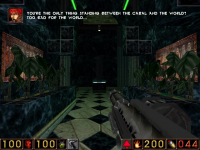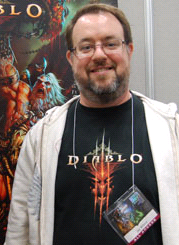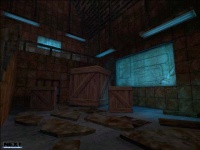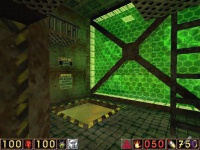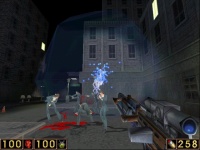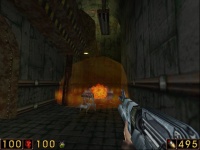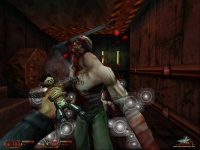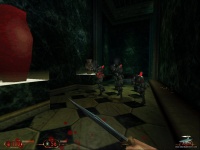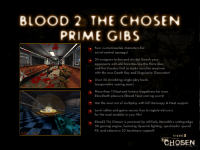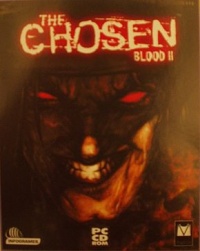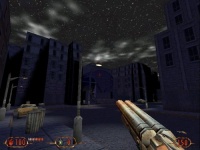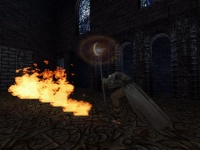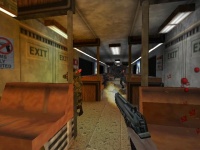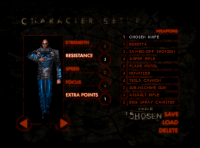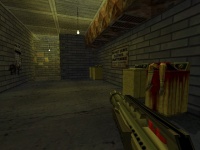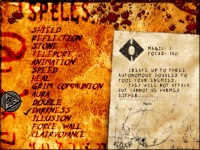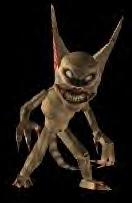Development of Blood II
Article outlining the production, design, and media coverage of the development of Blood II: The Chosen and The Nightmare Levels.
Production[edit]
"We've kicked around ideas for Blood 2, and they are exciting ideas, but we have no plans of pursuing them in the immediate future. Most of the Blood team will be turning our efforts towards Monolith's next big cutting edge 3D game. We are still seeking a title for it, but it will use DirectEngine, a true 3D engine with all the bells and whistles of Unreal and twice those of Quake. Oh, and Blood was just a warmup compared to what we intend to do to the gaming scene with this one. Consider this first project as clearing our throats before we truly sing and you'll get the idea! :)" — James Wilson III, April 19, 1997
Interest among the Monolith Productions staff for creating a sequel to Blood, a project stretching back to 1994, was not immediately high back in 1997. Most of the team were working on either Claw or early prototypes for what eventually became the LithTech engine and Shogo: Mobile Armour Division. Their publisher and rights holder GT Interactive however was interested in such a project and commissioned them to produce it within eleven months. The Blood trailer ends with text saying "Look for the sequel to Blood™ coming Hallowen '98", indicating the project was in motion by the time of its release; Jason Hall also mentions a potential sequel in the MONOLITH.TXT file included on the original game's CD-ROM. Nick Newhard, the designer of the first game, passed on the offer to design the second, and before long opted to leave Monolith behind entirely. Instead, the project was taken over by lead level designer James Wilson III, with his old role taken over by Bill Vandervoort.
Craig Hubbard, the secondary level designer, also played a role, but it was still subordinate to his efforts as the design lead for Shogo: MAD, and his role was thus replaced by Ben Coleman and David Kelvin. The Shogo team was supposedly meant to join the development effort after their game's release, but this took longer then expected which expedited the eventually rushed release of Blood II. There was some swapping between the Blood II team and the team working on Shogo: Mobile Armour Division, such as trees and toilet models for example, thus "team Shogo" is listed in the Blood II credits.
Blood programmers Peter Freese and Daniel Leeks had also already departed from the company, to be replaced by Greg Kettell and Scott Schlegel. Ken Silverman's role as Build engine creator was replaced by Mike Dussault as principle creator of LithTech, alongside Brad Pendleton. Artist Kevin Kilstrom returned to the project and was the person with the longest involvement in the original game to work on the sequel. He was rejoined by 3D artists Brian Waite and Aaron Carlson, as well as newcomer Eric Kohler as lead concept artist.
The music was composed by Blood composers Daniel Bernstein and Guy Whitmore and it alongside Shogo premièred the concept of adaptive music, meaning music that adapts to circumstance and location. Matt Saettler returned for business production alongside other management duties for the company, such as running its publishing wing, with his old project duties taken over by Karen Burger. Rick Raymo returned as GT Interactive's producer for the project, assisted by Marianne Arotzarena. Jason Hall continued his oversight role as CEO and as the actor for The Voice. Nathan Hendrickson joined the production as a writer, additional level designer and scripted sequence producer.
The game was originally meant to start with Caleb resurrecting the other Chosen after collecting artefacts from the Cabal and them forming a pact against CabalCo. From there the game could be played as either one of the four, or as up to four of them in cooperative play, all with a complete mutlilayered storyline. A legacy of this plot remains in this quote from the game's official website:
"Blood 2 begins with a scene in which the final element Caleb needs in order to bring back The Chosen is being held by the Cabal. Caleb retrieves this last object and returns to an abandoned building where he performs a dark ceremony to raise the other Chosen. The Chosen then form a shaky alliance against the Cabal, which has already dispatched a small army to deal with them. Meanwhile, something is warping the very fabric of reality, turning humanity inside out, and threatening the very world The Chosen hope to rule." — Blood II: The Chosen website
The development of Blood II was remarkable because of the community involvement by Jason Hall, the Monolith CEO, as well as others at Monolith including Brian Goble and James Wilson. He was often present on the Blood II forums, asking questions and getting feedback based on released screenshots and sound files. One watershed event occurred around August 9, 1998 when he polled the forum users as to whether they would like game play with one character (Caleb) and more story, or the ability to play through as all the Chosen with less story. The former was selected, although the ability to play as the Chosen was still made available, albeit with no canonical grounds. Hall would later state that maintaining this level of dialogue with fans may have produced unrealistically high expectations for the final product.
However, with popular games like Half-Life, Unreal (also a GT title), SiN and Thief about to be released, some of which boasted cleaner visuals, better AI, and more multiplayer options, the publishers of Blood II saw a need to quickly release the already delayed game. GT was in the midst of being bought out by Infogrames (later Atari, Inc), and due to the relatively small fan base, they pushed the game out the door before it could be fully fine-tuned, leading to several half-finished features and bugs; Jason Hall would also later state that GT held up the patching process after release, going into great detail in a July 2000 interview with Junk Extreme. The single player demo version was released on October 31, 1998, with a later multiplayer demo also released, and retail releases starting on November 20, 1998.
"Loki" Blackman attempted to bring the game, alongside Shogo and LithTech in general, to other platforms. This was originally only going to be for GNU/Linux but possibly eventually even Solaris and other Unix-like systems. In the end however this work was never completed, though it was later recycled in the Hyperion Entertainment ports of Shogo to various other platforms.
Weekly Updates and Visions[edit]
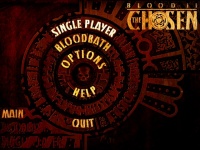
Starting on April 23, 1998 development was made public for fifteen individual weeks, off and on, in a manner similar to what was done for the original game starting in June 1996. Unlike the ones for Blood however, these were more generalized and featured a team member giving an insight into some part of the development process. The first entry, for example, featured designer James Wilson III touring the Monolith Productions office and snapping photos and writing short biographies of colleagues Paul Butterfield, Greg Kettell, Andy Mattingly, Kevin Kilstrom, Ben Coleman, Eric Kohler, Bill Vandervoort, Brian Waite, Brad Pendelton and finally his own office (as well as the bathroom cubicle, where "our best work has been done"). The next, on April 30, 1998, featured Bill Vandervoort describing the process for adding in an animated moving car in LithTech. Next up on May 1st was Scott Schlegel describing his work on the AI for Blood II with the misadventures of the Soul Drudge. The May 14th update was far more frivolous, with pop culture picks of stars for a hypothetical "Blood movie". On May 21st, Andy Mattingly described his work on the Blood II interface, including a somewhat fancier interface system and a spell book (similar to the Force Powers system from Jedi Knight). May 28, 1998 saw Ben Coleman show the life of a CabalCo Fanatic.
The June 4, 1998 update featured Brian Waite demonstrating the motion capture process for Blood II, as well as texture mapping for models. Next up on June 11th was Greg Kettell for an overview on the weapons and weapons modification, changing the Berreta into a toilet. On June 18th the update featured Eric Kohler describing the process of making concept art, character profile images, and other artwork. June 25th featured Daniel Bernstein describing the music composition process and adaptive music via Microsoft's Interactive Music Architecture; one of few to span only one page. Designer James Wilson then retook the reigns on July 10th to show the development of "C2L4: Cabalco Meat Packing Plant". Vandervoort subsequently returned on July 16th for a full on description of the level design process; another one page entry. July 27th featured a path-finding expose by Schlegel, while the August 17th posting featured a general project update from James Wilson, with categories for weapons, creatures, AI, game engineering, level design, and sound. The final entry on September 12, 1998 featured GT Interactive producer Rick Raymo enthusing about the game, and complimenting id Software's landmark title Doom.
Link: Blood II Weekly Updates
Monolith also released "Weekly Visions" on and off during the games development period, often pursuant to the release of the updates.
Link: Blood II Weekly Visions
Media Coverage[edit]
Note: This article shall heavily refer to the Blues News archives for rough dates tracking, noting that they may be just be when reported there, which often took a day, and not when first available or occurring. If a mentioned article or interview lacks a link, it is because it was not retrievable from the live web or Internet Archive.
Initial Announcements[edit]
"With Blood 2 we're really trying to do right by Blood. We think Blood was one of the best multi-player FPS's ever, and we intend to make sure that Blood 2 lives up to it not only by playing as well, but adding some new twists that will truly make it an original and visceral game. On top of that we're aiming at making Blood 2's single player game the immersive, and terrifying experience that it should be. A lot of thought is going into the single player game, and I think the gamer will see the result in the finished product. " — James Wilson III
The earliest development information for the game dates to a October 23, 1997 interview with designer James Wilson III by Operation 3Dfx, which mostly pertained to the status of the Direct Engine they were developing with Microsoft, as well as a discussion of the controversy surrounding violence in video games. Early promises were 32 player multiplayer, "original ideas" regarding cooperative play, and potentially several multiplayer modes such as deathmatch, capture the flag, teamplay and a version the Rocket Arena mod for Quake. It was also described how the game's levels were planned to be objective based with multiple solutions, differing from the key hunt basis of the original, and be linked together via a hub allowing back tracking as a single recognizable flowing world (although avoiding tedious mutli-level spanning switch quests ala Hexen). It was also announced that the game's complicated story would be told through in-game cutscenes. The interview also mentioned a potential third person mode as part of the engine, something partially implemented in the final release upon typing "mp_followme" in the conosle.
The first mention of Blood II on Blues News is on December 13, 1997, when it was reported that GameCenter published a now irretrievable sneak peak, followed by another irretrievable first look at Blood II, as reported by Blues News on December 19, 1997.

The first full preview published was by OGR on January 19, 1998. It described the game as using the Direct Engine, elaborated on some of the engine's capabilities (including coloured lighting, dynamic shadows, and motion capture animation), and stated that the game would work with hardware acceleration using either Glide or Direct3D; ultimately, Blood II shipped only with Direct3D support and a somewhat incomplete software renderer. The preview also announced the ability to play as Caleb or one of the three other Chosen, "each one will have his or her own special abilities and weaponry with which to dispatch the hordes of other-worldly scum that will inevitably be giving you static." It promised the game would have around thirty four levels, with eight Bloodbath maps and the return of all the old game's weapons, head soccer and the humiliation mode. Also promised were thirty weapons and spells, including a shredding spell; the final release has Focus magic reduced to just a weapons class. The story was also said to be set in 2030, a century after the first game.
The second preview published was by PC Gamer, mentioned by Blues News on January 22, 1998. It covered much the same ground as OGR, with designer James Wilson III promising a more engaging story with fleshed out characters "that interact with one another, each with their own goals and agendas." It elaborated upon the Chosen, "each of whom have their own strengths and weaknesses" in their battle with the Cabal. It also announced a four-player cooperative mode for each of the Chosen. Also promised was a return of the series' signature gore, promising that there would be "more ways to kill and be killed than in any other 3D first person shooter."
February 2, 1998 featured a now irretrievable interview with designer James Wilson III on Blood2.com, the predecessor to Planet Blood, which also launched the Unofficial Blood 2 FAQ on February 9th (and screamshots on March 28th and April 14th). On February 6, 1998, a sketch from Blood II was the Development "Pic" of the Week on Game Pen. Also, this period marked the beginning of screamshots being posted on The Blood Shack fan website (first on February 19th) launched on Voodoo Extreme as reported on February 2nd; this followed the launch of the similar Blood Stain fan website on February 1. February 16 featured an interview with designer James Wilson on the Daily Planet website, now not retrievable. An interview dating to early Feburary 1998 with Coming Soon Magazine remains online to this day, however.
Another preview for Blood II was published by Next Generation on March 10, 1998. Mostly describing Monolith's decision to use its own Direct Engine for the game, it also described the plot of the first game, before elaborating on the Cabal's hunt for the Great Betrayer and, as was originally intended, Caleb's resurrection of the Chosen at the start of the game. Otherwise it covered similar ground to the earlier previews with similar wording, aside from the promise that the AI would be "well balanced and entertaining to fight". A preview was also launched on March 11th by riot.com.au, but is now irretrievable. March 28th saw more screamshots launched on Blood2.com, a process that continued periodically thereafter.
Gamespot published a Blood II preview on March 24th which stretches on for nine pages.
Split with Microsoft, and E3[edit]
The split between Monolith and Microsoft regarding the Direct Engine development was first announced on Blues News on April 3, 1998, following the release of a demo version on April 1st; soon after, Shogo took on its final name in favour of "Riot". April 6 had James Wilson announce the imminent launch of the Blood II website, which occurred on April 15th, as well as officially confirming the title as Blood II: The Chosen, even though the project was not yet formally announced. April 7th had James Wilson interviewed by The Blood Pit, and Scott Schlegel update his .plan with word on his own competition in homage to Paul Steed's CrackWhore contest for Quake II, requesting a photo that "best captures the look and feel of the sexy yet ass-kicking Ophelia." Changes to the Blood II team were announced on April 11th, with James Wilson insisting they would not affect the development timeline. April 15th then saw the release of a LithTech demonstration film showing, among other things, clips from Blood II and Shogo.
OGR published a full preview of the game announced on April 17th.
April 20th had the official website release new details on the game's weapons, as well as new screamshots. April 21st saw the launch of the Weekly Visions on the official website, showing a "cool monster", while an April 20th update to the site demonstrated some weapons and released more screamshots. Totally 3D interviewed James Wilson on April 25, while Daily Dementia did a RealAudio interview with Jason Hall on April 27, 1998, and May 1st saw the release of LithTech editor screamshots. May 5 featured the release of a high rez wallpaper of Ophelia Price (followed by Ishmael on May 19th), May 7th had a new Weekly Vision, May 9th saw the release of a interview with Paul Butterfield on Voodoo2World, and May 11th had the official website run a quckie poll on the most wanted mod for Blood 2: CTF, Bumper Cars, Soccer, or Superheroes. Another Weekly Vision emerged on May 15th and on May 31st and June 19th.
May 18, 1998 was a watershed moment with the release of a very detailed preview and interview by The Adrenaline Vault, which featured much background information as well as screamshots and animations.
May 26, 1998 had The Blood Shack release many images of "the good guys, the bad guys, and their guns".
Both Blood II and Shogo were shown at the 1998 convention of the Electronic Entertainment Expo. OGR was first up to bat on June 1st with their impressions, mentioning the existence of a sort of hub system and the first reveal that not all of the game's weapons would be able to fit into the inventory at once. Blues News offered a preview of Blood II on June 3rd based on their first impressions, remarking that the game had yet to demonstrate anything to stand out compared to its contemporaries, and disappointment in apparent thematic changes compared to Blood. The Blood Shack released both textual and video coverage of Blood II at E3, heralding its launch as a standalone website. which has sadly been lost, on June 24th. Daily Dementia also caught snatches with James Wilson off the convention floor among many other interviewees released on June 2nd, with further talk on June 22nd and 25th. The Mecca World released an enthusiastic preview of Blood II on June 26th.
July 8th had 3D Gaming Net release a detailed feature on Blood II, plus interview with James Wilson. It announced that Blood II would feature a custom character attribute interface as well as playing as the four pre-set characters, but differ from a true role playing game in how these statistics remain constant thereafter through the whole game. Although at that point the distinctions between each of the four characters were not yet as well defined.
Narrowing Scope[edit]
July 24 had James Wilson announce that the amount of weapons in Blood II was going to be cut down from 30 to 21:
"We haven't really announced this anywhere, other than simply mentioning that we were in the trimming and cutting stages of development, but since I see regular posts on the Blood forum about the number of weapons in B2 I'll make it official. We've cut a few weapons from that original list of 30. Some were cut because of time, but most were cut because of redundancy and game balance. Basically, we eliminated any weapons that didn't serve a unique function, seemed out of place, etc. Our trimmed down list consists of 21 weapons. Almost all the announced weapons have remained." — James Wilson III
Some of the announced weapons were also modified, some to more closely reflect their Blood counterparts.
"There are a few that we changed cosmetically. For example, the rocket/grenade launcher is now the Napalm Launcher, an improved version of Blood's original weapon of fire and destruction. Rest assured that these changes will only improve Blood 2 as a game, since they will allow us to spend more time perfecting and balancing the weapons that have made the cut. Also, we're keeping some of the best remnants of those that didn't make the cut, we may still re-work them for a Blood 2 add-on. We'll be doing an update to the weapon's page on the B2 site in the not too distant future to show off the improvements we've made. It is our goal to make the most awesome and powerful arsenal ever seen in a 3D shooter, and I think we are well on our way to that goal. :)" — James Wilson III
The final released version only featured 19 weapons, including the inventory bombs, although the Flayer and Combat Shotgun were later reintegrated as part of The Nightmare Levels and added to the main game through the use of mods such as Extra Crispy.
Level designer Bill Vandervoort was interviewed by Game Hut on July 28th.
On August 8, 1998 it was reported that after polling the fan-base, designer James Wilson III had decided to scrap plans for the game's story campaign to be playable by each of the four Chosen, with only Caleb being eligible for the story mode. The campaign would however be playable as the other characters in a non-canonical "action" mode stripped of cutscenes. This also marked the end of the idea for full four player cooperative play. GT Interactive opened their official Blood II homepage on August 15th, which offered a discussion forum, a short synopsis of the game's story, and, notably, a release date, as the top of the page boldly proclaimed: Release Date: Halloween '98. On a live audio interview show called Shooters on August 27th Jason Hall assured the public that Shogo would be available in October with Blood II being released in the fall. New screamshots were also released on August 21st by Sharky Extreme.
September 1st had a release of a voice sample for Ophelia, while September 2nd had James Wilson audio interviewed by The Game Show in an episode entitled "Blood II The Good The Bad and The Chosen", and September 7th saw new screamshots posted on LithTimes. Wilson was also interviewed by Voodoo Extreme on September 10th, and interviewed again by PC Gamer on September 20th. These interviews still mentioned plans for a character customization interface for the game, which was cut back to Bloodbath only in the final release; all mention of a version of Rocket Arena mode were also dropped. September 10th also had Jason Hall announce a Caleb player patch for Monolith's recently released Gauntlet clone Get Medieval.
Following Shogo going gold on September 16th, various team members including Mike Dussault were transferred to the Blood II team to help speed up its completion as the deadline approached. Voodoo Extreme posted yet more screamshots on October 6th. The Blood Shack released its preview of Blood II on October 5th (following screamshots and a FAQ update on September 15th), the same day PC Gamer Online released an interactive interview with James Wilson and Gamers Digest interviewed Jason Hall.
Demo Release[edit]
Scott Schlegel announced a release candidate for the Blood II artificial intelligence on October 16, 1998.
"Got done a huge release candidate build for GT yesterday. The AI is looking a lot more pimp as well as deadly. Most navigation issues are taken care of while keeping low tick counts and NO SCRIPTING. Attacking tactics have been beefed up. The AI will deal and react to stuff like gunfire, bullet impacts nearby, differences in height, ledges, distance, damage and ammo amounts (the AI will take ammo and health pickups that are sitting around if they need them), searching and chasing, retreating, inter-AI fighting (Cabal vs monsters), etc. I have been playing through levels looking at how the AI behave in the actual levels. I can't even make it through a bunch of the levels and they aren't even done. The AI plays with the same restrictions and constraints as the player so there is none of that wack-ass bot crap like in Unreal. It is tough but reasonable and believable. And the best of all the AI is SCARY!!" — Scott Schlegel
The Blood Shack, LithTimes (October 14th) and Voodoo Extreme all kept the screamshots coming in anticipation of release. Another (not quite) Weekly Vision was released on the official website on October 11th, interestingly releasing items at a much slower pace than third party sources during this period, becoming almost monthly compared to other sites posting daily shots (The Blood Shack was reportedly receiving them faster than they could post them: "posting what was shot seven of ten yesterday, but today's shot is eight of 12"). Two shots were also posted on Infected Life and LithTimes on October 18th, as well as the haemorrhaging output on The Blood Shack (of which only some survive).
On October 21st it was announced that Blood II would be shown at the The FRAG 2 event. Brian Goble reported on the Blood II demo on October 20rd and later on October 23rd that work on finalizing the Blood II demo for a next week release was ongoing, with James Wilson earlier reporting on the demo specifications on October 20th:
"The demo will include 2 single player levels, about a half dozen creatures, around 8 weapons, Caleb as the playable character, and a few other surprises. It will feature most of our gameplay features, like guns akimbo, hit location, and limb loss. We're still speculating on what the creatures and weapons will be, so again, don't ask. :) It will be a good mix, though. The demo will not include multiplayer or save/load. This is to cut down on the demo size and testing (so we can get it to you sooner). We will most likely release a multiplayer demo after the game is completed. The demo's minimum requirements will be similar to the game's requirements, a P166 with 32 megs of ram. A D3D compatible accelerator is highly recommended. The demo will most likely run a little slower than the final game, only because of the lack of last minute optimizations that the final game will receive. The demo size is un-determined at this point, but you can count on it being at least as big as the Shogo demo (40 megs), and possibly bigger." — James Wilson
He also remarked that the retail release would be before American Thanksgiving, following the project's entry into beta testing:
"Blood 2 is officially in Beta testing. Actually it's been in testing for awhile, but as of last Wednesday we locked the code and are now concentrating on bug fixes, game balancing, and optimizations. Gold is not too far off! You'll definitely be playing B2 well before Thanksgiving. :) The levels are all in place. Bill, Ben, and myself are working on tweaking and adding details, and really crunching to get all the scipted cut scenes in. The levels are looking really good, with a broad variety of environments, and good atmosphere. I actually creeped myself out in one of my levels. :)" — James Wilson
The Blood Shack also upped the ante to posting ten new screamshots a day. October 25th had Brain Goble release this update:
"I just sent out a build of the Blood2 demo to the whole team! I am still waiting on a couple of level tweaks from billv and one more splash screen from gforce...but it's getting really close now. The second level's intro cinematic is incredible! ...I will be helping out as much as I can but my number one priority right now is Blood2. :)" — Brian Goble
October 26th also had Wilson further clarify that the demo would contain five monsters, and 6-7 weapons with Caleb as the playable character, and saw the release of a first glimpse of the game by Sharky Extreme. Given Blood II would now be missing its original retail release date of Halloween, James Wilson debated on October 27th whether or not the game was in fact definitively delayed given the game's imminent shareware release; a quote was also posted on Voodoo Extreme mentioning the possibility of a Blood II add-on for the first time "sometime after the first of the year." The Blood II demo was announced on October 29th by Blood2.com to be released on "the stroke of Midnight (Pacific U.S. Time) on Friday night!" at a file size of around 35 MB.
James Wilson further clarified that it would definitely be available by the weekend:
"Just a quick update. The demo is pretty much done on the content side, and is very cool. We're just working out a few of the bugs. Should be released very soon, definitely by the weekend. We've got an army of GT muscle ready to promote it for us, so once it goes up it should be available from a large number of sources. That's it. :)" — James Wilson
"Loki" Blackman also chimed in on alt.game.blood.
"The release date is to some extent up to GT Interactive, who are publishing. We just want to make sure the game is done and working well. :) Our release date is 'when it's done' - which is so far on target of the release date we've always had, of 'Fall 1998'. We're really close; the demo is pretty much done and should be out soon, and we're in bugfix, tweak, and optimization mode." — "Loki" Blackman
October 31st, the date of the demo release, also had Vooodoo Extreme update its LithTech FAQ. Brian Goble remarked:
"The demo is another hefty one...weighing in at a gory 36 Meg. It's got 2 levels, 6 weapons, some good baddies, and even a few cheat codes--but I'm not telling what they are... :) The full version of Blood2 is oh-so-close to being done and it is looking really good...the in-game cinematics are awesome! Being able to play any one of The Chosen characters is really cool too." — Brian Goble
Following the demo's release, Jason Hall announced an updated singe player demo (which Brian Goble mentioned as possibly delivered as a patch) and new multiplayer demo on November 3, 1998 in anticipation of the retail game going gold. James Wilson clarified these matters:
"Yes, we will be releasing a new and improved Blood 2 demo, mainly so people can see the speed improvements. The details are undecided at this point, but we will probably release it shortly after the game goes gold. ...For those who only play multiplayer, yes, we will be releasing a multiplayer demo. We won't release it until we get the updated net code that Shogo is testing out and integrate it into B2's code, which will be the Blood 2 point release, which should arrive in late November, early December at the latest. ...No, we haven't gone gold yet, but we are very close. We've frozen all content and are trying to work out the last of the bugs. That's all I'll say for now. :)" — James Wilson III
The new demo release was sent out on November 7, 1998 (with a patch on November 10th, announced on the 9th), as announced by Jason Hall:
"The new Blood 2 demo is out. The demo is another hefty 36 mb download, but is well worth it. It features many bug fixes, much improved speed/framerates, and is much more representative of the final product than the original demo. I strongly suggest that you check it out! It is not up on our site yet, but you can get it at www.blood2.com. Check out how fast it goes now! Wheee!" — Jason Hall
Retail Release[edit]
Jason Hall announced on November 6th that Blood II had now gone gold, as well as that the LithTech tools and game source code were soon to be released.
"Blood 2 is now much better optimized n' stuff and is now GOLD. GT has it and they are now "doing what they do" with it! Expect it in the stores very soon. Now that Blood 2 is gold, we are planning on re-releasing the more optimized demo. All that is really left for the new demo is for it to be tested (I'm installing it now - whoo hoo!). As soon as it passes all testing, we will make it available for the people who are interested! People who played the original Blood 2 demo and had speed/mouse/bug issues should be much happier with the new one.Once again, thank you all for your helpful input! This newer demo will also be a better gauge to determine how fast the final version of B2 will run on your system! ...Also, GT has green lighted the release of Blood 2's source and tools as well [as Shogo's], so when both games have all their stuff out there you are seriously going to be in 'CONTENT CITY'. It is hard for me to actually communicate how much MOD/TC power you are going to have in your hands. I can't wait to see what the community does with this stuff! " — Jason Hall
November 10th saw the first press analysis of the gold master for Blood II, with OGR releasing their initial impressions. It was complimentary to the game's weapons, items and level design, but more dismissive of its plot which it summarized as just chasing after Gideon. It also addressed the slight controversy that the two demo levels were too bright and technical, by promising that most of the game is darker and brooding. It also promised system resource usage improvements and remarked on a greater amount of multimedia assets than seen in Shogo, and complimented the people models in comparison. It concluded that Monolith had produced "another winner".
On November 13, 1998 programmer "Loki" Blackman announced an intention to port LithTech and games to Linux, subsequent to a transfer from the Blood II team onto the engine team following the game going gold:
"I finally got the ok to go ahead with putting together a Linux version of Lithtech and the LT games, beginning first with creating a server. Sometime in the near future, I'll be trying to put together a team to handle the Linux port - stay tuned for more info! I'm also open to porting to Solaris and other UNIX boxen; the port will be as clean as possible so as to work on as many architectures as possible. :)" — "Loki" Blackman
He also addressed setting up infrastructure for LithTech engine modifications in anticipation of the tool and source code release:
"I'm now the point of contact for people wanting to do mods for the Lithtech games (Blood 2 and Shogo). Of course, the source code to neither has been released yet, but Shogo's source and tools are impending pretty soon! If you'd spoken to me before about doing a large mod for Shogo or Blood 2, now might be a good time to re-establish contact. :) And as a little 'starter' for this, I've created two mailing lists for Lithtech game mod authors! One is for Shogo mods, the other for Blood 2 mods. " — "Loki" Blackman
Jason Hall was interviewed by Planet Riva on November 14th, an was also interviewed by LithTimes. The Adrenaline Vault gave Blood II a mixed review on November 17th. Brian Goble released a .plan update on November 18th instructing people how to implement custom sounds, while OGR released their final review of Blood II: The Chosen that same day. November 19th saw Daily Dementia release another RealAudio interview with James Wilson, where he stated he would not be involved in any kind of Blood III. November 20th saw reports that GT Interactive CEO Ron Chaimowitz had issued an apology to GameSlice editor Geoff Keighley for remarks against him that had somehow ended up in the "debits" section of the Blood II credits, of which Monolith claimed no knowledge of (indeed, GameSlice had actually written an optimistic preview of the original game as well as distributing a teaser video). Planet Shogo also ran a contest with one of ten copies Blood II or one of ten GameSpy registrations as the prize.
The game was released in retail on November 20, 1998 (with the game's box art first shown on The Blood Shack on November 17th). Brian Goble was also interviewed by Planet Blood on November 20th, with Blood2.com now having turned into its Planet incarnation. LANparty.com reviewed Blood II on November 3rd, which was complimentary but recommended waiting for the game to be fully patched. A "Blood 2 On-Line Chat" was released on November 4, 1998 with the game's developers by 3DGaming.Net. The same day Firing Squad released their game review which was highly detailed and spanned for thirteen pages and concluded that "generally doesn't break much ground, it remains focused on providing a solid foundation for a good FPS game". Planet Blood reviewed Blood II on November 30, 1998, concluding that "with a 3D card, and a reasonable spec computer you can be assured of a great gaming experience in Blood2."
Patching and Add-On[edit]
On December 9th, Brian Goble announced that work was under way on a retail patch for Blood II, while Planet Blood offered up a Q&A with Bill Vandervoort and Brian Gobe. Brian Goble had also been interviewed by Project 9 on December 8th. Blood II reviews were also posted by Sharky Extreme, which was quite detailed arriving at mixed conclusions regarding the game's uniqueness or innovation, and another by Evil Avatar, which was considerably positive.
December 14th saw an interview with Goble from Planet Blood, while the 21st saw a short three question Q&A with Goble about the multiplayer patch and the coming add-on pack. Another Q&A session with Brian Goble by Plant Blood on January 5, 1999 discussed the patching process and add-on design, and also mentioned tentative efforts towards a Blood III, which proved to be a false start.
The add-on was officially announced on The Adrenaline Vault on January 8, 1999. It clarified that the as yet untitled expansion would involve the Chosen's facing their worst nightmares, with more gothic and horror inspired levels ala the original Blood such as a haunted mansion, sorority house and western ghost town. Three new creatures were described, including the expansion's boss, the gremlin, and the return of the robed cultist from the original Blood (complete with shouted cultist taunts), as well as the addition of the Flayer and Combat Shotgun as weapons. There would be a new level played as each of the Chosen, with all new recorded dialogue. There was also to be an equal amount of an as then undetermined number of single and multiplayer levels.
January 9th featured Jason Hall announcing that the recently departed Daikatana developers known as the "Ion Eight" (then calling themselves BloodShot Entertainment, before later becoming Third Law Interactive) would be licensing the LithTech engine for what eventually became Kiss: Psycho Circus: The Nightmare Child released in June 2000. It features slightly updated versions of the Blood II tools, most notably DEdit and ModelEdit, but has slight incompatibilities.
Sharky Extreme published a preview of the third-party Blood II: Revelations add-on project on January 15th, following coverage by Games Alliance on January 12th. Blues News also mentioned the start of The Bloody Interviews series on Planet Blood. January 14th featured a RealAudio interview with James Wilson III by GameTime, while January 16th saw a mixed review of the game by WarZone. InterBurp Software also announced a contest with a copy of Blood II as the prize. James Wilson was interviewed as a Q&A about the add-on pack by Planet Blood on January 18, while Jason Hall was audio interviewed by the Lilith & Eve Show on January 19th.
January 21st saw a review of Blood II being released by MeccaWorld, which concluded that the game suffered from being overly ambitious and rushed out the door, decrying it as "an unfortunate trend in the video game industry". GA-Source reviewed the game on January 26th, with a mostly complimentary opinion, although noting the game and premise had a niche appeal.
January 23-25th saw Planet Blood posts screamshots of the in-development Blood II add-on pack, as well as "Loki" Blackman give an update on the 25th about the Blood II 2.0 patch and the Linux porting work:
"Most of my time of late has been going to the Blood 2 v2.0 patch... trying to fix AI quirks and generally make things smoother for the patch release. This has, unfortunately, meant a delay in the Linux porting efforts. However, I do have the Linux port ALMOST finished on the engine 25.5 build (I fell behind one internal build again), and will hopefully be able to sit down with Mike next week to merge the Linux stuff back in. As a side effect, this would mean that there would be not only a Linux server for Shogo (which will be moving to the same engine version for v2.2) but also one for Blood 2... and it should really only take a couple days after the patch stuff is done. I'm going to really try to allocate a couple days to finish that - since I know many people REALLY want it - before moving on to the Blood 2 mission pack add-on AI. Additionally, if I get the ok from PR/marketing, I'm going to put up a mailing list for the Linux port, to answer questions and give status reports on how it's going. :) — "Loki" Blackman
3DGaming.Net ran a contest called the 3DGN's Anime Giveaway, with prizes including releases from ADV Films (most famous as the initial North American license holder for Neon Genesis Evangelion), Shogo: MAD and later also Blood II starting on February 2, 1999.
Planet Blood posted more shots of the add-on on February 11th, while James Wilson III provided an update on it the previous day, as well as the latest multiplayer patch for the game and his next new project for Monolith:
"Looks like I've finally wrapped up my level work for the Blood 2 add-on. Although there's still a lot of other work to be done on the add-on, I'm pretty much completely moved on to Sanity, and I've started work on my first level. So far I'm really loving the change. :) Took a look at the Blood 2 multiplayer patch and it's looking really good. We're talking about some final game balancing issues, but at this point every build we do we hope is the last build, so it should go out soon. We sure do appreciate everyone's patience with this patch. We realize it's taken us longer than expected, but the extra time has guaranteed that we could do things right. I've been working on some personal projects in my spare time which I'll probably make available soon. Nothing big, just working on putting my web site up again and some other stuff. Watch this space for more info. — James Wilson III
While the Blood II team moved on to work on Sanity: Aiken's Artifact (although Wilson himself left the company for Cavedog Entertainment far before the game's completion), the Shogo team moved on to The Operative: No One Lives Forever designed by Craig Hubbard; there were some divergences however, most notably Bill Vandervoort being level design lead for NOLF. Both titles were given a new publisher, Fox Interactive, leaving GT Interactive behind after their troubled relationship during Blood II.
February 16th featured the release of more Blood II: Revelations screamshots onto Planet Blood. February 17th saw the release of the multiplayer patch, aka the point release.
The Nightmare Levels[edit]
On February 17, 1999 the official title of The Nightmare Levels was announced by The Adrenaline Vault, which also posted up a poorly archived page on weapons and enemies.
"After triumphing over the Ancient One, Caleb and the Chosen plot their return to the Otherworld. There they will face the Nightmare, a strong and powerful physic terror that creeps through the Wasteland. Features include: Four unique solo adventures in which each character faces his or her worst nightmare; six new multiplayer levels; a new multiplayer mode called Blood Ball in which participants play soccer with the heads of decapitated opponents; exclusive solo game enemies, including the menacing Gremlin, the sinister Nightmare, and the evil Cultist; new playable creatures for deathmatch including the Gremlin, the male and female Cultists, the Prophet, the Soul Drudge, and the Civilian; and two new weapons, including the flayer and the combat shotgun." — The Adrenaline Vault
This was also the day the 2.0 patch was launched. February 18th saw two more screamshots released by G-A Source, reported much the same details. February 19th featured a Q&A with James Wilson about the add-on discussing the story line, weapons, monsters, and more, as well as announcing the new point release for Blood II.
Blood II was reviewed by loonygames on March 8th, concluding that "if you long for the days before RPG elements started creeping their way into first person shooters, then check out Blood 2. You'll not only dig it, you'll think it's to die for."
Also on the eighth of March, Planet Blood published a letter from Jason Hall:
"Blood 2 source is on the way soon (VERY). With that users will be able to modify the heck out of the game. We will be releasing a Blood 2 patch soon (bugfixes) Users should expect a continued committed support effort from Monolith with regards to mods and level editing. We are still looking into the "High Ping" issue (this only happens on certain modems). We haven't found a way to fix that yet. We won't stop looking until we find and fix it. The Nightmares Add-On is coming out soon. It is quite p1mp. The main thing that I'd like to point out to the gamers is that Monolith is always doing the best that it can. Sometimes, that may not be good enough, but rest assured that we are working hard to satisfy. The frustrations that the Blood community has felt, Monolith has felt as well. We want Blood 2 to be as flawless as possible. We care about our game. We are doing the best that we can. That is all we can do. Trust me when I say that Monolith wholeheartedly appreciates the patience that the community has shown us." — Jason Hall
March 19, 1999 featured the launch of a preview of The Nightmare Levels by Gamespot, which basically covered the final release, despite is own prediction that more levels and elements were to be added into it. March 1999 also saw The Nightmare Levels reviewed negatively by GameOver.
March 23rd had Jason Hall interviewed by loonygames, while April 1st saw the release of the 2.1 patch for Blood II featuring fixes developed alongside The Nightmare Levels.
On April 5, 1999 the final update on the LithTech Linux porting effort was released by "Loki" Blackman:
"I've done a lot more work on the Linux port, and hopefully I'll have more good news soon. I've tried to keep the code relatively clean, but I haven't tried compiling it under FreeBSD or SunOS lately, so I can't swear I still compile perfectly under them. I'm still going to try to keep the UNIX port fairly clean so it should compile on more than just Linux." — "Loki" Blackman
Although never directly seeing the light of day, these efforts were later recycled in the ports of Shogo by Hyperion Entertainment in 2001.
On April 10th Jason Hall partook of a Q&A with Planet Blood about the release of the game's tools, internet play, he possibility that Monolith would offer "some limited support to a key mod group so that Blood 2 may live on and take some of the directions that various Bloodites would like it to take." On April 20th, Mike Dussault announced work on the next incarnation of LithTech, version 2.0. The same day the tools and game source for Blood II were finally released.
GA-Source posted an update on the status of Blood II: Revelations on April 26, as well as nine new screamshots on the 27th:
"Revelations is going very well, 75% of level design is now complete, with levels ranging from Temples, a warehouse, a train ride, a train yard, the city streets and many others. There are lots of original ideas and huge scripted parts in it, Cultists being thrown through windows by Shikaris, Zealots surprise attacking you, walls caving in. In revelations we have tried to re-capture the Blood 1 feel (with darkness and the element of surprise) but set in Blood 2 times, Here at Tequila we want to immerse the player into a world which is not only visually captivating, but also involves the player with what is actually going on in the surroundings, we also want people to feel emotions including fright and surprise. The coding is also near completion (including the Revelations launcher, front end ) but a few bugs are being ironed out at present." — Peter Hopkins, Tequila Software
May 4, 1999 saw The Adrenaline Vault give The Nightmare Levels a negative review, while May 25th saw the expansion reviewed negatively by GamesMania.
Aftermath[edit]
August 20, 1999 had The Habitat interview various mod-makers, including Tren of the Blood II mod FX Enhancer. October 22nd saw updates to the official FAQs for Blood II and Shogo. On November 15, 1999 it was announced that GT Interactive had been bought out by Infogrames, transferring the Blood properties to them. January 17, 2000 had GA-Source announced that Blood II: Revelations would be released as freeware, although in the end no files from the project were released until 2015.
On January 19, 2000 it as announced by The Adrenaline Vault that James Wilson III had been hired by Electronic Arts after his first post-Monolith employer Cavedog Entertainment collapsed during the development of Amen: The Awakening. They also published an interview with him about his latest project, The World Is Not Enough video game adaptation, on April 17, 2000.
On July 10, 2000 Jason Hall revealed the whole troubled story of the Blood II development and support process in a tell all interview with Junk Extreme, followed further by an August 2, 2000 interview with Planet Crap, in which he took aim at the game's publisher GT Interactive.
"It bothers us that Blood 2 happened the way it did, but the bottom line is that GT Interactive controlled whether additional work and support got done on Blood 2 or not. This concept is something that eludes most gamers. They think that Monolith could have just gone on and “fixed” Blood 2 if we really wanted to. Not true. I’ll explain why… GT Interactive completely owns the Blood franchise, not us. We were paid by GT to produce Blood 2. We were given 11 months to do it in. GT was our customer. As our customer, they had every right to take the work that we were doing for them, and ship it whenever they felt was the right time. Certainly, there were many factors involved with regard to why Blood 2 got shipped when it did, but all of those factors were based on GT 's needs and direction, not Monolith's. Monolith did not control the ship date (I wish we did!). Monolith did not hold Blood 2 in the air and say to GT, 'We are done! There is nothing more for us to do!' No, all Monolith said to GT was, 'Based on the amount of time we were allocated, and the various events that have occurred during development, here is where we are. If you want us to continue, here is what it will cost. We would encourage you to allow us to continue.' Then, GT shipped Blood 2..." — Jason Hall, July 10, 2000

The question of whether it is acceptable or advisable to delay a game versus narrowing the game's design actually came up during the game's development.
"It's not really my choice. We aren't in the position as a developer to perpetually delay a product. We're a smaller developer without an endless cash supply. But if I had to choose I'd say there is a middle ground there. If a developer delays they're product a year past their initial ship date than in my opinion they need to better estimate their ship dates. :) However, game development is hard to predict, and I think delays are sometimes inevitable, and always the smart way to go if they'll make the product better. It's a balancing act. If Blood hadn't delayed so much maybe we would have sold more copies, since our technology wouldn't have been as outdated. But I don't think 3 or 4 year development cycles are justified. If you can't make it in 12-24 months than your planning needs to be better, or you need to wait until a time when what you want to do is more possible." — James Wilson III, September 8, 1998
And indeed, Hall did admit some fault on Monolith's part for the situation.
"Over ambitious game design, unchecked team communication with end-users (i.e. a lot of promises got made by Blood 2 team members that shouldn't have been made), severe feature creep (GT wanted us to add stuff), etc. All these things contributed to the fact that Monolith could not get Blood 2 done and polished in the 11 months allocated. These underestimations are common pitfalls that developers make and wind up needing more time and money to finish their product. Monolith fell right into this trap, and GT was not interested in spending more money for a prolonged development of a product that would have limited success at best (due to the violence and subject matter)." — Jason Hall, July 10, 2000
Incidentally, the topic of communication with the community also came up early during the game's development.
"One of the biggest problems is players know what to expect before a game ever comes out, so they are never shocked, surprised, or scared when what they have known for months would happen finally does. This is why we are keeping such a tight lid on the levels and creatures of the game. I want people to experience those things, not read about them months ahead of time. Blood 2 will be full of surprises all the way through to ensure players never grow complacent. No, we do not think players are immune to fear, and we intend to prove it. " — James Wilson III, May 17, 1998
However the crux of the matter for many was not that Blood II was less ambitious than planned, but that it was poorly supported.
"Fixing Blood 2 on Monolith's dime would have killed Monolith. This is a fact. - And for what? To make GT Interactive slightly more money? The answer was "No." I feel really bad for the gamers that bought Blood 2 and were unable to have fun with it due to bugs. I wish it didn't happen this way, but there was nothing I could do. GT wasn't interested in paying for more development, and I was not going to send 65 families to the unemployment line just so that a minor few could have smooth internet multiplayer, or AI that didn't get stuck in corner, etc. Basically, Blood 2 just needed more time. Time costs money, and Monolith didn't have a business model with the Blood 2 project that could justify additional work - GT needed to step up, and really they should have because it is their game that they sold. To be honest though, I don't blame them for dropping it. The overall interest wasn't there for the Blood franchise (except for the Blood community, which r0x0rs). So there it is (in over simplified fashion). Monolith has certainly taken its lumps for the whole situation, and GT has, well, gone out of business basically (for many reasons), so there you go." — Jason Hall, July 10, 2000
He explained how Monolith in fact did not make any money from the sales of Blood II, only receiving payments to carry on development.
"I knew that if we attempted to fix Blood 2, Monolith would run out of money and go out of business. We simply did not have the money to do it. It would have cost Monolith close to $105,000 a month to fix Blood 2 properly, and we were looking at 3 months minimum. NO WAY. Why would I elect to go down that path? If GT (the people who own Blood 2 and the whole franchise) weren't willing to spend that money to support their own product, why would I spend that money (and risk people's job security) to support THEIR product? It doesn't make sense. You see, what gamers don't understand is that Monolith never received a single dollar from any Blood 2 sale. NEVER. Monolith did not take any gamer's money for Blood 2. Monolith did not put Blood 2 on the shelf and collect the fee. That was GT. If Blood 2 sold through the roof, GT would have made all the money, not Monolith. Our royalty was never going to see the light of day (this is the bad side of the business coming through). Maybe we would have made some money off of Blood 2 after it sold its 600,000th copy, but I knew that there was no way that was going to happen. So Blood 2 didn't get "fixed" by Monolith on Monolith's dime. Now, if we OWNED the Blood franchise this entire story would be different I assure you. Business models start making more sense when you are the owner." — Jason Hall, July 10, 2000
As to why Monolith remained silent on the situation despite the considerable backlash, Hall explained the business realities involved.
"Frankly, we did not want to upset GT. We were doing a lot of new business with them and it just isn't good, from a business to business side of things, to start complaining and pointing fingers at your publisher publicly NO MATTER WHAT THE REASON. The fact is that doing that could have placed future Monolith deals in jeopardy with GT, and honestly what other publisher would want to work with a developer that "pulls the curtain back" (so to speak) in such a public way when it is under the gun. No. That is not us. That is not me. It was a better business decision for me to decide that we were going to bear the brunt of the negative feedback, and that we would just keep our mouths shut and just do the best we could to support the Blood community with the limited resources that we had (which just wasn't enough). The game community really went after us too. It was very tough to just sit by and listen to all of the angry conjecture, misleading comments, personal attacks and pure unfounded theory on the whole mess that the Blood community had about the whole situation. Agreed though that there was a right for gamers to be upset at the situation, but all that Monolith pointing the finger at GT would do (even though it is the complete story) is basically create excuses for things that there really are no excuses for. So Monolith took its lumps. For a long time - and still takes some to this day." — Jason Hall, August 2, 2000
Seemingly in response to the patching crisis, Monolith released the game source code to modders on April 20, 1999, which lead to a proliferation of tweak mods right up to the modern Extra Crispy.
On January 4, 2001 the FAQs for Blood, Blood II and Shogo were revamped by Monolith. On March 1, 2001 it was reported by Blues News that the Bastard CTF mod for Blood II had reached version 1.0, and from there contemporary coverage ended.
Design[edit]
"Where to start? One of the most readily apparent differences is the four playable characters. Each one will play differently, and give the story a unique twist. We are still holding back some major details about the Chosen, but suffice to say the player will feel a real investment in their chosen character. Blood 2 also puts a lot more concentration on the single-player game than Blood did, with story-based, goal-oriented levels, advanced AI that emulates real creature behavior, a highly developed storyline with complex and engaging characters, a worthy and recognizable villain in Gideon, a menacing cast of baddies that throw in a lot of twists on what players might have come to expect from a bad guy, and atmosphere so thick you can cut it with a gore-covered knife. This is, of course, just to name a few things. Of course, some changes come as a result of technology. True 3D with mouselook changes the way 3D games play quite a bit, so much so [that] we are actually trying to overcome the technology through gameplay. We want to keep the same feel of the movement and weapon balance, and translate those things into a new style of gameplay. A tricky maneuver, but one I think we are doing well." — James Wilson III
LithTech[edit]
Being one of two launch games for the engine, the other being Shogo: MAD, a lot of emphasis was put on what LithTech would bring to the game.
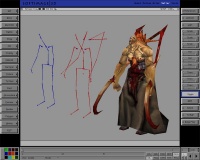
"Blood 2 uses the Lithtech engine, which is getting a lot of attention through Shogo, which is nearing release. Most web sites that have previewed Shogo say the graphics are better than Quake 2, but not quite as good as Unreal, but the performance is better, and the special effects are better. So from a graphics standpoint Blood 2 looks great. The single player game has a lot to offer beyond good graphics though. The environments are creative and based around real locations, with some really impressive looking levels like a moving subway train, an airship in flight that you can walk around on outside, and a rather gruesome meat packing plant. There is a fairly complex story that is told throughout the single player game, involving many primary and supporting characters, and several dramatic confrontations as well as times where the other three Chosen will fight alongside you. Progress through the single player game is very logical, and moves almost like a movie. Using Lithtech's LOD system we can display a LOT more models on the screen at one time than either the Quake or Unreal engine, which allows for gameplay where you are fighting a lot more enemies at a time." — James Wilson III
James Wilson also provided a more complete list of features he was enjoying, both in the game and the engine.
"A character system that allows for complete customization of character attributes, including physical attributes, inventory items, and weapons, including many weapons dual-handed. Motion captured animation. Hit detection on creatures which allow for body-specific recoils and deaths on the creatures. Dynamic limb loss creating an almost infinite number of death animations. Multiple modeling techniques on the same model, like deformation and jointing, which allow us a much greater diversity of look with the models at a lower poly cost. 250 levels of detail on models, which means we draw less polies the further away from the model you are, but with 250 different transitions there is no popping in and out of polies. 700 or 800 poly models can be processed down to as little as 200-300 polies at a medium distance. Those are just some of the features, but we have a whole host more obvious features, like dynamic lighting, AI scripting, 21 different weapons, over 20 creatures, advanced AI, and such. I'd say my favorite feature is either the motion captured animation or the levels of detail. The mo-cap makes a huge difference in bringing the creatures to life, more so than I thought it would. You can really tell the difference between it and hand animation. The levels of detail allow us to have a lot more enemies on the screen at once, which is also a big plus, since that has been a limitation of 3D-based engines. " — James Wilson III
It was also stressed that the two launch titles were still intended as games, separate ones at that, and not just engine demonstrations.
"Speaking for myself, I'm far more interested in making a fun game than a good technology demonstrator. If you have a competitive engine and take advantage of it as a game designer, the technology pretty much demonstrates itself. The cooler the game is, the more impressive the technology seems. Otherwise, you get people saying things like, "Wow, just think what a creative game developer could do with this engine!" We intend to settle that question with Riot and Blood 2. :) I think one of the engine's greatest strengths is its flexibility. Riot and Blood 2 are both looking incredible, but they both look incredibly different as well. There are features in Blood 2 you won't see in Riot and vice versa, because we've let game design determine how we use the technology rather than trying to demo every possible engine feature in both games." — Craig Hubbard
It was hoped this next generation engine would prevent the game from being marginalized due to using an outdated rendering engine the way Blood was.
"Well, Blood was certainly well-received in a lot of ways, and we're really proud of it, but we don't think it got the attention it deserved due to the fact that it used outdated technology. With Blood 2 our main goal is to make a game that is as fun and engrossing as Blood was. Along the way we're also hoping to improve upon the things we didn't like about Blood, and add a few new ways to look at the genre in general." — James Wilson III
Mention was also made about how the engine made things easier for the people behind the game.
"Everything is easier. I find myself making engineering requests that would have been near impossible in Build and having my engineers say, "Have it in an hour." Often, stuff that took months of tweaking and finesse in Build comes out the first try. We have been able to transfer some of our Blood code over, mainly for movement and to capture the spirit of some effects. From the level design side of things it was incredibly liberating, at least after that first cognitive leap into 3D design. I spend all my time putting in cool stuff instead of fighting with the engine. Still, I miss Build from time to time. It was a good, fast engine, and level development was faster and in many ways easier, but technology improves, and Build certainly had its day!" — James Wilson III
Emphasis was also put on duplicating the fast, smooth movement of the original game despite the now heavier graphics.
"There are several things about going to a 3D engine that can slow things down, some of the major ones being mouselook, which makes hitting targets and hitting them accurately more difficult, and environment navigation, generally due to more complex architecture. We are going to overcome the mouselook problem through weapon design. Plain and simple, you will have more power in Blood 2. Some characters will be able to carry two-handed weapons all the time instead of with a guns akimbo power-up, and many weapons will be beefed up. Not all the weapons will be more powerful, though... Other than improved mouselook, we have emulated character movement almost exactly. We had to make a few minor tweaks, mainly because our characters, and therefore their viewpoint, are taller. This affects the perception of speed and jump height, so we beefed these up a tad." — James Wilson III
The designers were also concious of the problems that can occur when trying to produce smooth movement within fully three dimensional engines.
"The area of effect weapons, like rocket launchers and such, will probably be scaled back to reflect the fact that they are more powerful in a true 3D engine, due to the ability to use the walls and floors to detonate these weapons near opponents.... As far as the player negotiating geometry and objects, many 3D action games have done a good job of keeping the floors and walls relatively free of obstructions, but there are two things that interfere with and slow down the action. The first is jumping, which I find to be generally unresponsive in many games. Blood 2 will emulates the quick, smooth jump of the first game that makes it easy to get on top of things and control where you land. The other is getting stuck on stuff. Be it walls or other players, there are many games where you simply touch a wall or another player and come to a screeching halt. This will not be the case in Blood 2." — James Wilson III
This was all tied to a strong design emphasis on smooth movement as a whole, as was the case for its predecessor:
"Movement is absolutely the number one priority for an action game. It's how the player interfaces with the world, so NOTHING is more important. It takes tons of work to get movement right. Getting the movement in Blood to the state it was at for the final game took dozens and dozens of revisions, and getting Blood 2's movement right has required the same amount of work. Most shooters seem to have fairly slow movement that is under-sampled with a pathetic jump. Not Blood 2. Movement is fast, control is strong, and the jump is good. We have taken a lot of Blood's original movement code to assure all of that." — James Wilson III
Designer James Wilson III also hoped that the team's previous experiences and complete control over their technology would produce a polished, bug free game.
"Yes, much more stable for many reasons. Blood was our first product, and our testing base was not nearly as well-developed as it is now. We learned, and Claw came out almost bug-free. I expect this to be the case with all future products. We also have the advantage of a more engineers on this project. We have three Blood 2 engineers, plus the Riot engineers and the LithTech engineering team, who will be spending several months just on compatibility testing. We have learned our lesson as well. Blood 2 will be more rigorously tested than Blood, and we will freeze the feature set earlier in development." — James Wilson III
In the end however, Blood II became notoriously buggy due to its rushed release by its publisher, exacerbated by a difficult patching process in terms of acquiring support from GT Interactive.
Themes[edit]
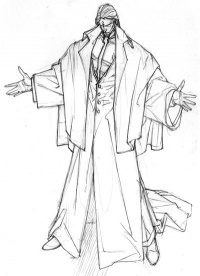
James Wilson III had desired to provide Blood II with a more realistic horror experience, as opposed to the somewhat cartoonish feel of the original Blood.
"We had a clear vision of Blood 2's world before we started, and this will make it a lot more realistic. The player will not only be able to recognize the places that they are in, but from level to level the world will stay consistent to the point that it will seem like a continuous world. On top of that, we've gone a long way to define within the story exactly what kind of world the Blood 2 world is, so it will feel like a very rich and immersive environment to kill things in. :) Speaking of story, it is pretty complex, and evolves within the game instead of cut scenes at the beginning and the end.." — James Wilson III
However, he was quick to point out that Blood II would not be betraying its fast action roots, being willing to compromise realism where necessary.
"I think it depends on what type of game you are going for. I think a game based around realism could be made and could be great, but it's going to play very differently from something like Quake. Realism tends to make for a much more strategic game, versus a fast-paced one. Simply adding realism to a game like Quake is in my opinion a mistake, because it contradicts what the game is going for in the first place. I wish people were making more shooters aiming for realism, like Goldeneye and Outlaws, because we have plenty going for fast action, but I don't think watering down a fast-paced game with realism is the answer. Blood 2 is going for an extremely fast pace, so we take LOTS of liberties with realism, but we do it on purpose, for the gameplay." — James Wilson III
And despite all the hype being propagated about LithTech, he was quick to point out the necessity for a game-play focused design.
"First and foremost a game has to be fun to be great. It has to be satisfying and challenging, without needless frustration. I think a lot of things prevent this from happening, emphasizing technology over gameplay, over-designing a game, and/or adding features or realism for the sake of having them even though they make gameplay suffer. I think if you look at any great game you'll find that at its core it is extremely focused in the style of gameplay it goes for. Practically any idea can be made fun, but the gameplay has to be well-conceived and thought out. There are other things that are important, good concept, technology, overall consistency, but you can sacrifice in some areas and still have a great game, although if you sacrifice in technology no one may care. :)" — James Wilson III
Most of all he wanted to craft a genuinely horrifying game, closer to the original design for the first game:
"We wanted Blood to be a horror game; that was one of the intentions from the beginning. We all have a pretty sick sense of humor, and with time that creeped its way into the game. Since Build was not the best engine for displaying atmosphere, at least not when held up to Quake, this humor started to fill in where the atmosphere failed. We are all very happy with the end product, but now that we have an engine that can lay down the serious mood, it would seem a shame not to take advantage of it, especially when games like Duke Nukem Forever will provide all the humor players could ever want. No 3D action game has gone the true horror route. There will be a hefty dose of humor in the sequel; however, overall it is a more serious, more terrifying experience." — James Wilson III
To achieve this, Wilson set out hoping to craft a genuinely menacing atmosphere.
"As any good movie director will tell you, it is all about implementation. Sure, plenty of horror films use the old "cat trick" to scare you, but occasionally a movie goes a step beyond and truly taps into something unsettling, and then the viewer knows fear. This is what we want to achieve with Blood 2. A sense of menace in the world is extremely important. The player should not feel that something is going to jump out at them around every corner; it becomes expected, and is no longer frightening. Instead, the player should be fearful of where danger will come from next, and what that danger will be. Are they being hunted at that very moment? Was that creak in the floor from their own foot, or the foot of something much larger that is waiting, just out of sight? The player should never be able to predict what is going to happen next because it kills the fear." — James Wilson III
Although originally hired as a level designer, James Wilson III hoped that the Blood II project would allow him to stretch his talents as a writer.
"From a personal standpoint, I want a story-oriented game because, at heart, I am a writer. Before getting involved in the gaming industry, I wanted to be a novelist, and had already developed a draft of my first book. All my game ideas start with the story and develop from there. This is the case with many of Monolith's game designers, including Nathan Hendrickson and Craig Hubbard, who wrote the extremely complex and cool story for Riot. Craig has a degree in professional writing, and Nathan was a professional writer before coming to Monolith. I think this is a current trend in first-person shooters simply because it is the least explored area of the genre. Is it the way all shooters should go? No, not necessarily. Good game design should always be the winning factor, and I think any title with awesome gameplay will do well regardless of the story. Story is not always a good thing, either. I have played plenty of great action games where I felt I was muddling my way through a story I had no interest in. I still played, though, because the gameplay was there." — James Wilson III
He particularly wanted the story to feel like it developed meaningfully as it progressed.
"The story will twist and turn several times, developing the characters and going in new directions as the player discovers the ramifications of what's REALLY going on. The story links heavily into events that occured in Blood, as well as events that occur in Blood 2. My goal with the story for Blood 2 is to make it much more than just window dressing for action, or a setup for why you are killing things, but rather a complex set of events that all relate to one another. The characters will develop over the course of the game, and your opinions about them may be vastly different by the end. The player will constantly be discovering elements of what's going on that will remain consistent throughout. Like a character in a movie, the player will have to deal with events that may occur unlike they expected, and will be constantly intrigued regarding not just what is happening, but why." — James Wilson III
Consideration was also made on how interactive storytelling could do things different from conventional narrative.
"I think the main thing you can do is invest the player in the story in a way that simply can't be done in any other medium. In a movie or book you basically follow the actions of someone else, with no control over how the story turns out. But in a game the player becomes the character. A victory feels more satisfying, and a defeat is more painful. I think this has only been touched on in computer games, mainly because up until very recently story has taken a back seat to gameplay. I think in a way that should always be the case, but in the future I think we'll see more games that have a whole section of the team that is just working on the story and accomplishing elements of that." — James Wilson III
Despite a vast hundred year time jump from the past into the near future, James Wilson argued that the game's setting was still derived from that of the original.
"Blood 2 takes the world that was established in Blood and gives it depth and substance. I have gone to great lengths to not simply tack a story onto the end of the first game, but to integrate the two games together. Even things we simply made up for fun now have purpose and reason, and every major element is expanded and given a history... Many people have expressed concern that the sequel will be sci-fi because it occurs in the near future. Let me assure you this will not be the case. The world is one ruled by what was only a shadow in the first game. ...This world is a time of repression and despair, a future hopelessly caught in the past that is quickly deteriorating around them. In this way, I view Blood 2 as a tribute to Blood and the time period it was set in. We did not move forward in time to get away from Blood, but rather to romanticize the world in the way only long-term history truly can." — James Wilson III
At least a few elements were directly inspired from ideas cut from the first game. Concept art from 1994 shows that both the Bone Leech and Soul Drudge were originally created for use in Blood, appearing very much as they would later be realized in Blood II.
Even so, many reviewers missed the more overtly gothic and anachronistic aesthetics of the original, and the two demo levels (C1L6: Center for Disease Management and C1L7: Movin' On Up) were regularly challenged as being too bright and "techie" for a game with the pedigree of Blood.
Structure[edit]
Blood II was originally intended to be non-linear, objective-based and contained within a open hub (similar to the Hexen games), requiring some amount of back-tracking:
"All the levels are goal based, with no key hunting, and advance the story appropriately. You will have very well defined reasons for being where you are, and fairly involved goals, some of which will be vastly divergent from your typical run and gun. You will also be able to freely move back and forth between levels, but we are taking great pains to make sure that this is not cumbersome. You won't be hitting switches on one level that do something on another. Returning to levels will be done for a reason, and will present new dangers, and possibly new areas to explore. Players can also expect the innovation in our levels that they saw in Blood with levels like the Train." — James Wilson III
Elements of this original design can be seen in the similar nature between C1L2: Pickman St. Station and C1L10: Hard Hat Area, with the player even able to enter C1L11: The Cathedral from the former using no-clipping cheats. Similarly, there is repetition with C2L5: Horlock's Station and C2L8: Horlock's Station 2, as well as the related trilogy of C1L1: Cabalco Transit System, C2L1: Cabalco Transit System 2, and C2L7: Cabalco Transit System 3. Finally, there is same with C3L4: Cabalco Enterprises, C3L6: Cabalco Enterprises 2, and C3L8: Cabalco Enterprises 3 in the third chapter. This adaptation of the earlier model into a simpler linear model has been a source of criticism for the game, with some reveiwers commenting that the player revisits the same locations a few too many times.
Early on James Wilson III admitted that this more ambitious form of level design was going to be more work, but was optimistic anyhow.
"Story and mission structures invest the player in the game and give them something to fight for. They have also made for more interesting levels on the whole. Goal-based levels are more work, but my original specifications for Blood 2, which I created before the project went into production, had 90 percent of the levels planned out, both in terms of story and goal content. This has been a wonderful tool for organizing the designers. We had nearly two hundred partially completed levels for Blood when we were done, mainly because we never had a plan of what the levels were going to be. Blood 2 will have almost no excess because we knew what we were going to do from the start. A few levels have been scrapped and re-designed, but most were pulled off on the first attempt. The main complication has come with resolving how the story will unfold for each of the four separate playable characters, and how the levels will work together regardless of which character you play. Challenging, to say the least, but if it were not challenging, it would not be fun!" — James Wilson III
The Chosen[edit]
"I hope [players] find the Chosen, the playable characters, the most unsettling part of the game once the story comes full circle. Their grim insanity is really the catalyst for the most horrific aspects of the game. I am very proud of what we have done with them as a whole...The Chosen are not there as wall decorations, or to deliver the occasional quip, but are distinct personalities, catalysts that drive the story." — James Wilson III
A major selling point for Blood II: The Chosen was its inclusion of four playable characters in the form of the Chosen.
"One of the most readily apparent differences is the four playable characters. Each one will play differently, and give the story a unique twist. We are still holding back some major details about the Chosen, but suffice to say the player will feel a real investment in their chosen character." — James Wilson III

This was a design idea carried over the from the original Blood development.
Although in the end only really predominate in multiplayer, they were all intended to all have an active role to play as protagonists of the story.
"Caleb has a slightly more prominent role than the other three Chosen, mainly because he is the catalyst for much of what is going on, but once the game gets underway he is treated as an equal character, and only features more in the cutscenes when you specifically play him. We have worked hard to make sure the other three Chosen get just as much attention. " — James Wilson III
The final decision to make only Caleb have a story mode in the game was the result of development time pressure, and was settled upon following an online poll in July-August 1998 asking if users preferred a stronger story with Caleb in the focus, or a weaker story made to work with all four Chosen. The single-player campaign can still be played as any of the four, but only Caleb receives story text or experiences the game's cutscenes.
This also lead to the final story where the Chosen are resurrected gradually through the game via the Singularity Generator. Originally Caleb was to begin the game by collecting the artefacts needed to bring back the Chosen from the Cabal, and then have the four of them form a pact.
"Blood 2's story is pretty involved. We are only revealing the setup for the story right now. Blood 2 starts off 100 years after Blood in the year 2028. Caleb, Blood's main character, has continued his crusade against the Cabal, the ancient organization dedicated to the Dark God, Tchernobog. Caleb was a servant to Tchernobog and leader of the Cabal who was cast down from his position in the first game. He fought the Cabal and destroyed Tchernobog out of revenge. At the beginning of Blood 2 Caleb is trying to figure out a way to regain his position as head of the Cabal, which has grown in size from a backwards cult to a huge global organization that fronts its activities through a megacorporation called "Cabalco". He discovers the location of several artifacts that are in the Cabal's possession that will allow him to bring back "The Chosen", the three others like Caleb who were killed in Blood 1. The game starts off with Caleb bringing back the Chosen in the first level and them joining Caleb in a shaky alliance to retake the Cabal. Little do they know that their actions and the events from Blood 1 could result in the end of everything." — James Wilson III
In terms of implementation, Wilson placed the statistical variations between each of the Chosen into various categories.
"The differences in the characters revolve around their physical attributes, and a special ability. Physical attributes are Speed, Strength, Resistance, and Magic. Speed controls how fast the player moves. Resistance controls how much damage the player can take. Strength controls how much ammo the player can hold and some aspects of recovering health. Magic controls how much magic ammo the player can have, and how fast magic ammo regenerates, and some aspects of how armor is recovered." — James Wilson III
He then defined the values for each of the characters based on these lines.
"The differences between the characters are that each have different default values of these abilities. Caleb has high strength, average speed and resistance, and low magic. Ophelia has high speed and magic, but low strength and resistance. Ishmael has high magic, average speed and resistance, and low strength. Gabriella has high strength and resistance, but low magic and speed. Each character also may have a special ability, but we haven't finalized that yet." — James Wilson III
The player was to have the option to modify the basic statistics for their character within certain parameters.
"Blood 2 offers something that no 3D shooter to date has offered: in-game character customizability. You can modify and customize your character's physical attributes and weapons, allowing each player to customize their playing persona to their personal style.... You can modify any character's attributes as you see fit. For example, Ophelia has high speed and magic, but low strength and resistance. You could crank up Ophelia's strength by pulling it away from her resistance. You can also swap special abilities. By default each character is very different, but since you can change attributes at will you aren't limited to their default configuration. Yes, this means all the characters can basically be the same on a gameplay level, so you may be asking what's the point of having multiple characters? We didn't want multiple characters to act as a restriction on the player, preventing them from using certain weapons or having certain abilities, we wanted the player to decide what they wanted there character's abilities to be, so we've put those things completely in the hands of the player. — James Wilson III
This was pitched as a way to allow players to create character types even beyond the four standard models provided.
"Want someone fast but with high strength? That option isn't one of the defaults, but is still possible. I think putting these decisions in the hands of the player is very important, because it allows the player to make the game what they want it to be. The other thing I like about this system is that while it adds elements of a role-playing game, it doesn't slow down the action at all, since all these decisions are made when you originally make your character, and not altered in the game itself. The individual characters have default values so that players who don't want to mess around with creating their own character don't have to, but rather use the character that suits them the most. We'll also include several pre-made versions of each character for a variety of quick options." — James Wilson III
James Wilson did however stress the ways that Blood II still differed from a full on role playing game.
"Blood 2 allows a lot of customization of the player's characters, but it is not a role-playing game. Keeping that in mind we decided that you would not gain experience or new abilities throughout the game, at least not moreso than any other shooter. When you start the game you can choose any one of the Chosen's pre-set values, or you can alter attributes about them. This effects four major elements of the character, attributes, weapons, inventory items, and spells. Attributes define all the physical aspects of the character, movement speed, ability to withstand damage, and weapon and magic capabilities. Players can trade points back and forth between different attributes by taking a point away from one field and adding it to another. Once chosen these values remain consistent throughout the game. The weapons field is limited in single player, basically you can choose one weapon from a few starter weapons. In multiplayer you choose your entire arsenal and start the game with your weapons in hand, although with insufficient ammo to use them. Items and spells are gained throughout the single player game, but in multiplayer you also choose these ahead of time." — James Wilson III
Ultimately none of the above made it into the single-player game (though it is available for Bloodbath), and instead players simply choose a character based on their pre-defined statistics. This proved to be to the game's detriment, as demonstrated by mods such as FX Enahncer and Extra Crispy which were partially designed to tweak the hard-coded character attributes that were originally going to be dynamically alterable. For example, in EC the amount of Focus given to certain characters has been changed, allowing the default character of Caleb to make greater use of magical weapons; Caleb can now actually make use of the alternative fire mode of The Orb.
However, Wilson still saw value in even this limited implementation from an aesthetic point of view.
"Finally, having different characters is appealing simply from an aesthetic standpoint. With each character you not only get a different look, but different height (which affects your first person viewpoint), and tons of unique one-liners and dialogue that give your on-line persona personality. :) The dialogue is, of course, optional." — James Wilson III
Gameplay[edit]
James Wilson III stated prominently how the Blood series gameplay differed from that of the first-person shooter standard bearing series Quake.
"One of the main things I think Blood 2 has to offer is that it isn't Quake, and it doesn't play like Quake. Even most non-id 3D shooters can't say that. But Blood 2, like Blood, simply offers a very different style of game than Quake. The movement is faster, the jumping is higher, many weapons can be used dual-handed, and the weapons are a lot more powerful. Bloodbath also just has a lot more style. Four playable characters each with a lot of personality and one-liners that are used during the game. Humiliation Deaths, which allow you to mock your defeated opponents. You can use many weapons dual-handed, one in each hand, and nice touches like the "voice", an in-game multiplayer commentator, and being able to kick around body parts, and dynamically dismember dead bodies. Sure these are just bells and whistles that don't affect gameplay, but they certainly add to the fun." — James Wilson III
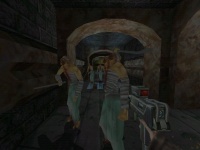
The original Blood featured only one principle antagonist: Tchernobog's Cabal. Blood II however features two: Gideon's CabalCo, and the forces of another reality penetrating into our world loosely directed by The Ancient One. However, this roughly translates enemies into being the same as the previous game's two primary categories: humans and monsters, with the second game not seeing the return of any of the Cabal's beastly minions or zombies (save for Hands). However, the enemy list for the game was still a key focus for the game's designers.
"And on creatures, that area has been one of our main focuses. They are simply cooler than any creatures I have seen in a game. I don't like to say such non-descriptive statements, but it is hard to explain in an interview. Zombie-like Soul Drudges stagger at you, swinging a variety of bludgeoning weapons. The spider-like thief attaches to your face, causing nausea in the form of screen effects, and the human enemies use a variety of weapons and techniques, like dodging, and running while firing. Most of the movement has been motion captured, so the creature animations are much more vibrant and realistic than most other games. Also, the design of our creatures allows for a much broader arrangement of play styles. In Unreal, for example, they have smarter enemies, but fewer of them. In Blood 2 we have a variety of situations, smart enemies that you fight one-on-one, dumb enemies that you fight in large groups, and a nice mix in-between. The humans can be mowed down in a way that hasn't been seen since Doom, but some creatures will take a serious beating before going down." — James Wilson III
In order to bring them to life, the artificial intelligence in Blood II was intended to be quite ambitious, but was left somewhat half-finished in the end.
"I think Blood 2's AI is very strong. Instead of trying to emulate a bot with our AI, we're trying to make them act like real creatures. Real creatures have a will to live, and will not always make the player their first priority. Human enemies have a variety of skills they can use. They carry multiple weapons, have limited ammo, and can pick up new weapons and health. They also have tons of animations they can use. You won't see the enemies run at you, stop, and then fire. They'll roll from side to side, forwards or backwards. They'll fire while running or walking at you, attack crouched and standing. Some of the creatures can attach to you to do damage, and you must hit your 'use' key repeatedly to get them off. Some enemies work together, some have mortal enemies other than the player. Some enemies use special abilities like teleporting, or jump over and around you to through off your aim. I think people will be very impressed with Blood 2's creatures and the code that drives them." — James Wilson III
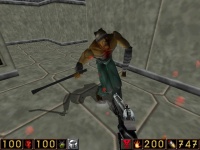
Indeed, it was claimed that the game's enemies would posses realistic human-like sensory perception.
"We've tried to make an AI system that is not only advanced, but goes in a new direction for game AI. Everyone seems to be concerned with making bot-level AI, but bots don't really reflect how creatures would actually react. I don't want to fight a deathmatch opponent in single player, that's what I play deathmatch for. I want to fight an enemy that is afraid to die, gets angry and goes into rages, makes mistakes, and practices smart tactics. Our creatures use realistic senses, like sight, smell, and hearing, and having individual strengths and weaknesses. Some prefer to attack in groups, some are braver than others, they'll fire at your last position, and many other techniques." — James Wilson III
All of this based on a fine tuned fuzzy logic system by programmer Scott Schlegel.
"Scott Schlegel is working on the AI, and he's created an incredible fuzzy logic system that allows for a large variety of emotional states and reactions. When the fanatic, a militaristic member of the Cabal, gets injured they may activate a pack on their back that injects them with a berserker fluid that will send them into a mindless rage where they can take enormous damage and run straight at the player. After 20 or so seconds the pack on their explodes, turning the crazed fanatic into a suicide attack! The Shikari, an extremely intelligent pack hunter, will attack in groups, is as good in water as out, and can crawl on walls and ceilings. Players can expect a lot of other reactions, like fear, anger, and AI that work intelligently in groups." — James Wilson III
Blood II was different from many other games in having a large arsenal of weapons (19 at retail, 21 with the expansion, out of an originally planned 30), of which only ten could be carried by the player at one time. In the end this was a point of some criticism, as many players found it tedious to have to drop old weapons to pick up new ones, and not all the weapons were given the same effort to develop and balance.
"We didn't want to restrict the player to a certain weapon setup. In games that have done that I've always been frustrated by the inevitably smaller number of weapons you could carry at once, and the fact that my favorite weapons would be spread across several characters. In Blood 2 any character can use any weapon. There are around 20 weapons total, but the player can only carry 10 weapons at a time. In single player when the player reaches their maximum of 10 weapons they must drop a weapon they are currently holding to pick up a new weapon. In multiplayer, you choose all your weapons ahead of time, and spawn in with a full arsenal but with little or no ammo. You don't pick up weapons in multiplayer, only ammo, items, and power-ups. So even though you may have the big bfg weapon when you spawn in, you won't have any ammo for it. Also, many weapons can be used dual-handed, like carrying a shotgun in your left and right hand, but that requires two weapon slots, one for each hand." — James Wilson III
Others however have instead given the game praise for how it offers the players a very varied arsenal with weapons other games would have eschewed as niche. The game was specifically marketed with promises that it would offer "more ways to kill and be killed than in any other 3D first person shooter."
"Most of the weapons from Blood will make a literal or functional return in Blood 2, the voodoo doll being a noteable mention. Some of the new weapons include a magical weapon called the Flayer, which is essentially a large iron hook. When the player uses it they can direct long hooked chains at their enemy that rip and tear at their skin. One of the other new weapons is a basic Beretta 9MM pistol. Don't expect this to be a weak weapon, though. Like a real Beretta, the player can fire it fully semi-auto, as fast as they can pull the trigger. Of course this weapon is also a natural for dual-handed use. Anyone who has ever seen a good John Woo film knows how satisfying this can be. :)" — James Wilson III
That said, the initial idea for potentially over thirty weapons was cut down considerably during development.
"I'll say it right here and right now, Monolith is the king of weapon balance! :) We all play so many games and we'll keep kicking something and kicking something until it is perfect. That's what happened with Blood, and we all think the weapon balance turned out wonderfully. Actually, though, it looks like we are going to have less than 30 weapons after all, mainly because some of the weapons were either redundant or out of place within the context of the game. The weapons we have will be better for it, and there will still be more weapons in Blood 2 than almost any shooter out there!" — James Wilson III
James Wilson III also felt that the function of the weapon should be to empower the player and feel enjoyable to use.
"There is no such thing as too much power! All right, maybe that is a little dramatic, and not even completely true, but it is not too far off from how I feel about weapons in games. I take a page from the Peter Molyneux book, one of the designers whose work and philosophy I admire: I play games to be empowered. The first time I saw a meteor blacken the countryside in Magic Carpet, my jaw hit the floor, and I want people to feel the same way when they play a game I design. Flying around a corner with guns blazing and tearing apart everyone in your path, or taking out multiple targets with a single rocket blast. That kind of power is satisfying, and I will take that any day over the frustration of an under-powered and useless weapon. Who enjoyed using Quake's shotgun? Or even the super shotgun for that matter? Shotguns should shred an opponent, not annoy them." — James Wilson III
However, he still maintained that this emphasis would not necessarily get in the way of producing a balanced weapon set.
"Some people argue weaker weapons are more balanced, but I disagree. I think Blood's weapons were very well balanced other than a few hitches, such as the Voodoo Doll alt. fire and the Life Leech. Weaker weapons are not as much fun, and having fun is why I make and play games. This debate will probably go on and on, but I have seen enough to convince me we are on the right track. There are a lot of serious players at Monolith, many of which only play one-on-one games, where weapon balance is a critical part of the design. Blood is still everyone's favorite because the power of the weapons is just enough it allows for a good fight while keeping the action and the kills fast and furious. So the answer? The same people will have the same complaint about Blood 2, and probably even more so." — James Wilson III
Rather than rest on their laurels from the first game, James Wilson hoped to innovate the first-person shooter in a number of ways.
"I think execution is an extremely important, and often under-rated, aspect of any game, and Blood 2 will certainly deliver there. Still, I view Blood 2 as a very innovative product. The primary leaps forward in this genre have been technological ones, not gameplay or design ones. Technology is cool, and we certainly have that, but nobody is doing anything that advanced 3D programs have not been doing for 10 years now, including us. Once the jump to true 3D was made, the advances beyond that have been nice, but certainly nothing has been done that changes how games actually play. It is time for design to have its day. Blood 2 will be one of the few products aimed at expanding the 3D action genre beyond its current constraints by incorporating major elements of other genres into a completely new game design concept. Obviously, the features I am talking about have not been announced, so I cannot give specific examples. What I will say is everything we have shown of Blood 2 makes it a contender, and if we had nothing else I still think we would compete on a purely content-based level. The really ground-breaking concepts behind its design have only been hinted at. To me, everything we have shown so far is gravy; I have not even started talking about the real meat and potatoes yet. " — James Wilson III
In the end however, with the removal of the non-linear interlocked levels, a magic system (partially revisited by the Voodoo mod), fuller character customization, reliable limbloss (later remedied by a modification by Andy "Guzz" Guillaume), and a storyline viewable from four different characters, all for the sake of development time expediency, the best praise Blood II got was from not diluting its core gameplay with innovative risks and instead sticking to the fundamentals. Many noticed a distinct lack of elements in Blood II to make it stand out among the crowd, particularly against recent releases such as Half-Life or even its stable-mate Shogo; several even criticised the game for having key hunts at all. In time however, many have come to respect the version of Blood II released as is in terms of a fun old-fashioned action shooter, rather than dreaming of the more ambitious game that could have been.
Nightmare Levels[edit]
"So anyway, there we were at the end of the production cycle, with a Blood 2 product (that GT decided to ship) that really could benefit from some patchwork. Ok, that is fine. Blood 2 is owned by GT, and they can ship and sell whatever they want, whenever they want. Monolith has no say in that. BUT - we all felt that we needed to do something, thusly the Nightmare levels add-on pack was born. Basically Monolith and GT had the idea to build a simple add-on pack (something that GT was willing to pay for - since it would be an additional product for the channel and perhaps keep Blood 2 evergreen) and during that time, use some of the money they gave us to work on a Blood 2 patch. This sorta worked, as we were able to fix some things, but the bottom line was that Blood 2 was going to need a lot more money if we were going to get it to a truly polished state. That proved to be impossible to accomplish with the small advance we got to do the add-on (which invariably suffered as well). So after all this was done, GT (having other internal financial issues) pretty much decided that they were done with the Blood franchise. They were not interested in spending any more money on that property at all. End of story." — Jason Hall, July 2000
The Nightmare Levels was largely devised as a means of providing the Blood II patches to customers at retail, a point made more necessary due to the unpolished nature of the original retail release. Back in 1998 the availability of reliable high-speed Internet was limited enough that downloading patches from the game's website was prohibitive for many gamers; indeed, even the game's demo was considered troublesomely large by many. The expansion was also necessary due to the reluctance of GT to keep funding the game beyond its original development period, something it was marginally more willing to do in the name of development of a new retail product that would also promote new purchases of the original. However, the full price GT charged for what is essentially a glorified patch and, somewhat threadbare, content extra provoked a considerable backlash from both the press and from players.
As had been done with the earlier Plasma Pak expansion released for Blood, The Nightmare Levels built upon dropped design elements from the original Blood II. This includes integrating the cancelled Flayer and Combat Shotgun weapons, as well as the removed Gremlin opponent. Even The Nightmare itself was originally conceived during the parent game's development. Also, although still not playable by each character, each member of the Chosen gets one level shown from their perspective, an ambition dating very early on from the Blood II development. Full blown Head Soccer was also implemented, finalizing a notorious recurring element of the series, as well as developing the side character of JoJo. Gideon narrates the pack, as was originally intended and even recorded for Blood II before late storyline changes necessitated its removal. Players were also given the ability to play as additional characters during Bloodbath, such as the male and female Cultist, the Prophet, Soul Drudge and the new Clown Guard.
Many elements in the add-on pack were designed to evoke nostalgia for the first game, most notably the first level designed to slot somewhere into the second episode of Blood, complete with chanting robed cultists (as opposed to the business suit wearing version from Blood II) remade on the LithTech engine. The third level also homages E1M4: Dark Carnival, while the fourth recalls E2M5: The Haunting, bringing back the prominence of the Hand opponent which had been shared virtually unchanged between Blood and Blood II. The second level is not even indirectly based on Blood, but carries over that game's tradition of basing an entire map on a horror reference, in this case the films Re-Animator and Night of the Creeps.
"In a lot of ways, we want the add-on to recall the feeling of Blood, as opposed to Blood 2." — James Wilson III
"[I am most excited about] the return of the robed Cultist from Blood 1, complete with sound effects. :) I think the strongest aspect of the Blood 2 add-on is the idea that we didn't want to create a tack-on to the Blood 2 story, but rather have fun with our concepts in the Blood world. By tack-on I mean that most add-ons are footnotes to the storyline of the original product. In the original game, the player fights the greatest evil/villain/mutant ever seen, and in the add-on they clean up whatever's left, like they're running janitor duty. :) For the Blood 2 add-on we came up with a campy idea that would allow us to have fun with the characters, settings, and enemies, creating a whole new experience apart from Blood 2. We also plan to take advantage of the multiplayer enhancements that will be added to Blood 2 by the multiplayer point release. We'll be adding quite a few new multiplayer levels and at least one new multiplayer mod." — James Wilson III
The expansion is also quite tongue in cheek in nature, even ending with Ishmael breaking the fourth wall during Gideon's epilogue, and starting with the Chosen sitting around a camp-fire together roasting "weenies". In fact, Gideon's entire narration for the pack is glib.
"We didn't want the add-on to be as serious as the original game, so the storyline for the add-on is there more for setup and humor's sake than anything else. The add-on picks up where the first game left off, with the Chosen stranded in the Ancient One's realm, trying to make their way back to Earth. They set up camp one night and begin to tell scary stories about their past around the campfire. This attracts the attention of the Nightmare, a creature that inhabits the Ancient One's realm. The Chosen are then subjected to their greatest nightmares one-by-one before Caleb finally faces off with the creature itself." — James Wilson III
According to Joel "Reactor" Blackwell, the team behind the Gods 2 fan add-on project convinced Monolith to get Stephan Weyte to record some custom dialogue during the recording sessions for The Nightmare Levels; it seems likely that this was also the point where the new Caleb dialogue for Blood II: Revelations was recorded.
See Also[edit]
Resources[edit]
- Changelog.txt
- Press release
- Planet Blood on LithTech
- plan file archives
- Blues News archives (December 13, 1997 - March 1, 2001)
- Bloodlust news updates
- Concept Art Image Gallery
- Blood II development footage on YouTube
- Release Dates - Transfusion Forums
- Blood 1/2 Title Fonts - Transfusion Forums
Previews[edit]
- Preview - Next Generation (March 10, 1998)
- OGR's Coverage of E3 - Blood 2: The Chosen Preview (June 10, 1998)
- Blues News - 1998 E3 Round Up: Part Two - More FPS Games
- The Blood Shack E3 Coverage
- Preview - PC Gamer
- Blood 2 Looms: Halloween 1998 - OGR (January 19, 1998)
- Preview - OGR
- Blood 2 Initial Impressions - OGR
- 3D Gaming Feature - Blood 2
- Game Pen's Development Pic of the Week -- Blood 2
- Blood 2 On-Line Chat - 3D Gaming
- The Blood Shack preview
- Gamespot preview
- Mecca World preview
- Gamespot Nightmare Levels preview
Interviews[edit]
- 1998 interview with Coming Soon Magazine
- 1998 interview with PC Gamer
- Talking nasty with Monolith's Jay Wilson (Blood 2) - Voodoo Extreme (September 8th 1998)
- Jay Wilson Blood II interview from The Adrenaline Vault
- Jaw Wilson Blood II interview from 3D Gaming.Net
- Interview with: James Wilson, Blood 2 Project Leader
